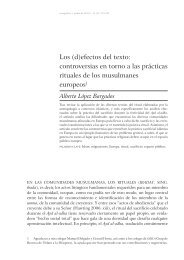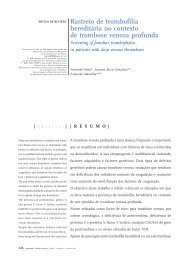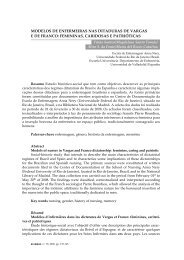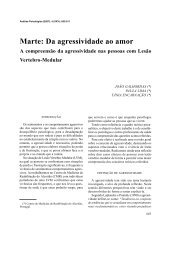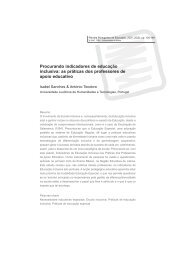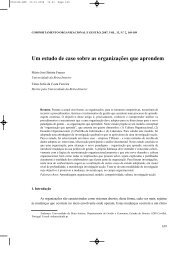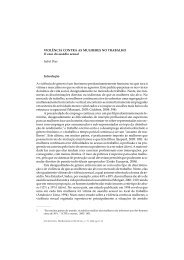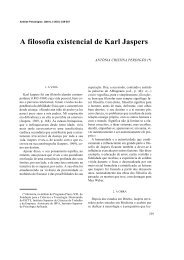Sobre o choro: Análise de perspectivas teóricas - SciELO
Sobre o choro: Análise de perspectivas teóricas - SciELO
Sobre o choro: Análise de perspectivas teóricas - SciELO
Create successful ePaper yourself
Turn your PDF publications into a flip-book with our unique Google optimized e-Paper software.
Frodi, A. M., Lamb, M. E., Leavitt, L. A. et al. (1978).<br />
Fathers and mothers responses to the faces and<br />
cries of normal and premature infants. Developmental<br />
Psychology, 14 (5), 490-498.<br />
Frodi, A. (1981). Contribution of infant characteristics<br />
to child abuse. American Journal of Mental Deficiency,<br />
85, 341-349.<br />
Frodi, A. (1985). When empathy fails: Aversive infant<br />
crying and child abuse. In B. Lester & C. Boukydis<br />
(Eds.), Infant crying (pp. 107-123). New York: Plenum.<br />
Furlow, F. B. (1997). Human neonatal cry quality as an<br />
honest signal of fitness. Evolutional Human Behavior,<br />
18, 175-193.<br />
Gibello, B. (1979). Fantasma, linguagem, natureza:<br />
três tipos <strong>de</strong> realida<strong>de</strong>. In D. Anzieu, B. Gibello, R.<br />
Gori et al. (Eds.), Psicanálise e linguagem (pp. 45-<br />
-57). Lisboa: Morais Editores.<br />
Godfray, H. (1991). Signaling of need by offspring to<br />
their parents. Nature (London), 352, 328-330.<br />
Gomes Pedro, J. (1985). O comportamento do recém-<br />
-nascido (3): estádios e a activida<strong>de</strong> motora. Jornal<br />
<strong>de</strong> Psicologia, 4 (4), 19-26.<br />
Gori, R. (1979). Entre grito e linguagem: o acto da fala.<br />
In D. Anzieu, B. Gibello, R. Gori, et al. (Eds.), Psicanálise<br />
e linguagem (pp. 103-104). Lisboa: Moraes<br />
Editores.<br />
Grafen, A. (1990). Biological signals as handicaps.<br />
Journal of Theoretical Biology, 144, 517-546.<br />
Grossman, K. E., & Grossman, K. (1991). Attachement<br />
quality as an organizer of emotional and behaviour<br />
responses in a longitudinal perspective In C. M.<br />
Parkes, J. Stevenson-Hin<strong>de</strong>, & P. Harris (Eds.),<br />
Attachement across the life cycle (pp. 93-98). London<br />
e New York: Ed. Tavistock e Routledge.<br />
Lebovici, S. (1987). O bebé, a mãe e o psicanalista.<br />
Porto Alegre: Artes Médicas.<br />
Lester, B. (1987). Developmental outcome prediction<br />
from acoustic cry analysis in term and preterm infants.<br />
Pediatrics, 80, 529-534.<br />
Luzes, P. (1983). Da emoção ao pensamento. Dissertação<br />
<strong>de</strong> doutoramento não publicada, Lisboa: Universida<strong>de</strong><br />
<strong>de</strong> Lisboa.<br />
Lyon, B., Eadle, J., & Hamilton, L. (1994). Parental<br />
choice selects for ornamental plumage in American<br />
coot chicks. Nature (London), 371, 240-243.<br />
Malson, L. (1978). As crianças selvagens. Porto: Livraria<br />
Civilização.<br />
Morley, C., Thornton, A., Cole, T., Fowler, M., & Hewson,<br />
P. (1991). Symptoms and signs in infants<br />
younger than 6 months of age correlated with severity<br />
of their illnesses. Pediatrics, 88, 1119-1124.<br />
Murray, A. D. (1979). Infant crying as an elicitor of<br />
parental behaviour: an examination of two mo<strong>de</strong>ls.<br />
Psychological Bulletin, 86 (1), 191-215.<br />
Newman, J. (1985). The infant cry in primates: An evolutionary<br />
perspective. In B. Lester & C. Boukydis<br />
(Eds.), Infant crying (pp. 307-323). New York: Plenum.<br />
Rouchouse, J. C. (1981). Éthologie <strong>de</strong> l’enfant et observation<br />
<strong>de</strong>s mimiques chez le nourisson. Psychiatrie<br />
<strong>de</strong> L’Enfant, 1, 203-249.<br />
Spitz, R. A. (1988). O primeiro ano <strong>de</strong> vida (5.ª ed.).<br />
São Paulo: Ed. Martins Fontes.<br />
Widmayer, S. M., & Field, T. M. (1981). Effects of<br />
Brazelton <strong>de</strong>monstrations for mothers on the <strong>de</strong>velopment<br />
of preterm infants. Pediatrics, 67 (5),<br />
711-714.<br />
Winnicott, D. W. (1957). The child and the family: first<br />
relationships. London: Tavistock.<br />
Winnicott, D. W. (1988). Os bebés e as suas mães. São<br />
Paulo: Ed. Martins Fontes.<br />
Winnicott, D. W. (1989). De la pediatrie à la<br />
psychanalyse (2.ª ed.). Paris: Ed. Payot.<br />
Zahavi, A. (1975). Mate selection – A selection for a<br />
handicap. Journal of Theoretical Biology, 53, 205-<br />
-214.<br />
Zahn-Waxler, C., Friedman, S. L., & Mark, E. (1983).<br />
Children’s emotions and behaviours in response to<br />
infants’ cries. Child Development, 54, 1522-1528.<br />
RESUMO<br />
O <strong>choro</strong> tem sido vastamente estudado como indicador<br />
<strong>de</strong> diagnóstico <strong>de</strong> <strong>de</strong>sor<strong>de</strong>ns <strong>de</strong> foro neurológico.<br />
Contudo, os contributos dos teóricos preocupados<br />
com a interacção mãe-bebé sugerem, ainda que indirectamente,<br />
a importância <strong>de</strong>sta manifestação – <strong>choro</strong><br />
– no contexto da relação entre o bebé e uma figura privilegiada.<br />
Lebovici sublinha, aliás, a importância do<br />
<strong>choro</strong> neste contexto quando diz: «basta imaginar o<br />
que seria a tarefa dos pais na ausência dos gritos: eles<br />
<strong>de</strong>veriam então adivinhar quando o bebé tem fome,<br />
quando ele está sujo, e quais são as suas diversas necessida<strong>de</strong>s<br />
e <strong>de</strong>sconfortos. Em <strong>de</strong>finitivo, uma situação<br />
no primeiro contacto mais calma e menos ansiogénea,<br />
seria uma realida<strong>de</strong> mais preocupante, pois então ela<br />
constrangeria os pais a se interrogarem quase <strong>de</strong> maneira<br />
permanente sobre o estado do bebé.» (Lebovici,<br />
1987).<br />
Esta reflexão eminentemente teórica, que <strong>de</strong>senvolvo,<br />
procura enquadrar o <strong>choro</strong> numa série <strong>de</strong> mo<strong>de</strong>los<br />
teóricos diferentes e, a partir <strong>de</strong>ssas abordagens, discutir<br />
a sua importância e função, no domínio da interacção<br />
mãe-bebé.<br />
Palavras-chave: <strong>choro</strong>, interacção mãe-bebé.<br />
ABSTRACT<br />
Infant crying has been vastly studied as a diagnostic<br />
indicator of neurologic disor<strong>de</strong>rs. However, contributes<br />
from mother-infant interaction theory suggest,<br />
333



